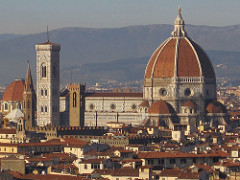
-solved chief problem by adding double shell
-simplified overdone means of support by reducing weight of masonry
-herringbone brickwork pattern takes weight off
-substituted horizontal cable chains with stone ribs
-designed all scaffholding
-invented special hoisting apparatus for transporting business material
-first work of new style
-blend of liberal arts and applied sciences
-proportions and visual harmony
-medieval and classical
-perspective construction

– Brunelleschi
-1st public building done by Brunelleschi
– aisleless church= transitional style with corbels of open timber roofs
-unfluted column shafts, corinthianesque capitals
-roundels in spandrells
-shallow domes in bays of loggia
-groin vaulting
-flat ceilings in interiors
-regularity of plan, artistic structure
-romanesque arch in tuscany
– module- centralized and symmetrical
-placing of this building determined layout for the rest of Piazza
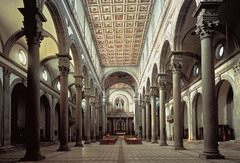
– Parish church of Medici Family
-patron= Giovanni de Medici
-centralized basilican plan, latin cross
-lacks a facade, unfinished
-plain cube with zone of change of pendentives forming transition into inscribed circle of dome- characteristic of brunelleschi
-umbrella dome over cube of sacristy and crossing
-famous imposts between capital and arches in nave
-blend of romanesque with gothic spatiousness
– Pilasters @ end of each colonnade to support floating entablature
– Twin colonnades separating nave from side aisles & arched openings separating side aisles from chapels → variant of loggias facing another
– Double-arch → arch above entablature echo bigger arches separating the nave from the side aisles

-Dedicated to St. John the Evangelist
-Giovanni de’ Medici buried in one of the chapels
-Relief by Donatello in roundel of St. John = patron saint of the Medici
– San Giovanni → he identifies himself w/ his name saint
– Cosimo de’ Medici also buried @ underneath dome/crossing of the church
– Growing family ambition → “founder” now tradition to bury @ crossing
– Floor tomb → more extensive use of rare stones + coat-of-arms
– In red/green inscription → “Pater Patriae” = “father of the fatherland”
-Fluted Corinthian pilasters supporting entablature = width of chapel
-Pilasters intersect at a right angle @ the corners
– Walls rising up to arches → fusion between squares & circles
-Arch of Constantine → potential influence arch & pier construction
-String course replacing entablature
– Masses of private intentions in family chapels → Medici tombs
-Same module governing S. Lorenzo also present in Sacristy
• St. Lawrence = patron saint of Cosimo de’ Medici
• First time Brunelleschi treats wall surface like sculpture as a whole
-Suggesting depth & malleable wall like Michelangelo

-original plan rejected, erected new church so entrance front faces piazza
-module= square of crossing
-continuous aisles round transepts
-semicircular chapel niches
-perfectly symmetrical
-arcade: clerestory ratio= 1:1
-enhanced sculptural massiveness
-sturdier columns
– impost blocks
-piers frame niches in exterior
-more massive structure than S. Lorenzo, spatial effect arising from powerful sculptural quality of individual members
-scenographic vista with no single observer, interplay of geometrically abstract and solidly concrete perceptions
-picture + mass
– discovers plasticity of walls
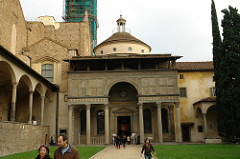
-patron= Andrea Pazzi (rival of Medici)
– to serve as chapter house of monastery and assemblr room for family
-site’s shape determined by existing parts
-remains model of perfection and strict logic
-scenographic effect on cloisters
– most ornate decoration with color harmonies
-prototype of form
-Variant of Old Sacristy @ San Lorenzo by Brunelleschi → but dome looks higher & floating
-High altar topped by dome; pietra serena; Della Robia roundels & frieze

-completely centralized church
-1st example of new style and capital importance
-use of construction of piers from central space with radiating chapels
-octaganol center
-conceived in terms of mass: 3D substance of piers which shape all parts of space
-influenced by ancient roman monuments
-plasticity of wall
– perfect synthesis between medieval and classical
-unfinished
-set standard
-inspired by the antique Temple of Minerva Medica in Rome
-exterior was flat with recessed niches

-Patron= Luca Pitti, principal supporter and friend fo Cosimo de Medici
-closely resembles Palazzo Medici but bigger
-ashlar rustication, gives severe and powerful atmosphere
-roman style architecture
-exterior- prison like due to continuous additions later on each side
-rigid, flat, static facade
-design and fenestration suggest that fancelli was more – experienced in utilitarian domestic arch than Alberti’s humanist ideals
-Palace bought by Medici family in 1549 → became chief residence of the ruling families of the Grand Duchy of Tuscany
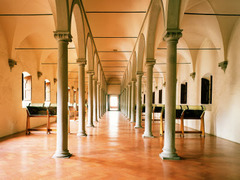
-Supreme simplicity
-lucid and perfectly proportioned
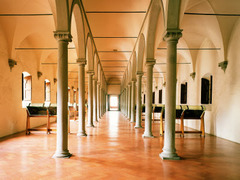
-plain ionic capitals
-pedestals to columns in cloister
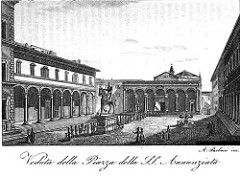
– patron=ludovigo gonzaga
-simplistic
-halls with chapels with intersecting tranverse walls between nave pillars and outer walls of bays
-rotunda= exact copy of temple of minerva medica in rome
-added equally plan and monumental chancel
-unfinished, later finished by alberti
-underwent many renovations
-vestibule= architectural ornament
-• Portico inspired by Brunelleschi’s Ospedale degli Innocenti
• Addition of the tribune w/ radiating chapels behind high altar
o Circular choir = rotunda → Michelozzo in 1444
o Rotunda later finished by Alberti from 1469-1470
o Rotunda = exact copy of the temple of Minerva Medica in Rome
o Dramatically remodeled by Alberti → even removed some of Michelozzo’s components of the rotunda
o Alberti eliminated ambulatory = wide open space under dome
• Rotunda is much higher than rest of church → almost separate from rest
• Clerestory pierced by large windows spaced out evenly
• Strong cylindrical structure

• Tiny coffered barrel-vault archway in the chapel → single arcade?
• Supporting Corinthian columns in front & Corinthian pilasters against the wall
o Four variations of capitals
• Insertion of entablature between columns and arch
• Coffered vault → Masaccio’s Holy Trinity for stone masonry
• Patron = Cosimo de’ Medici
• @ Piano nobile → main residence never situated on ground floor
• Permission to build private chapel w/ portable family altar (papal connection)
o Dedicated to the Holy Trinity → church authority = prestige
• Nearly square room & on a step higher also square altar separated by pair of Corinthian pilasters → elite manufacturing → colored/ancient stones $$$
• Pictorial program → frescoes by Benozzo Gozzoli in main room and fresco altarpiece by Filippo Lippi in altar w/ angels on side walls
o Adoration of the Child, Filippo Lippi, 1460
o Procession of the Youngest King (east), Benozzo Gozzoli, 1459-1460
o Procession of the Middle King (south), Benozzo Gozzoli, 1459-1460
o Procession of the Oldest King (west), Benozzo Gozzoli, 1459-1460
• Altarpiece also of the Holy Trinity → God, Holy Spirit, and Christ united
Magi Chapel, Palazzo Medici-Riccardi, Michelozzo, Florence, begun 1444
• Patron = Cosimo de’ Medici
• @ Piano nobile → main residence never situated on ground floor
• Frescoes continuously processing on surrounding walls
• Some figures modeled after real Medici family members (i.e. Cosimo)
o Artist paints his self-portrait w/ Cosimo de’Medici
• Some figures modeled after real Medici family members (i.e. Cosimo)
• Medici identifying themselves w/ the story of the 3 Magii to prove wealth
o Position of wealthy bankers problematic in terms of the Bible
o Linking wealth & piety in ancient as well as contemporary terms
o Defends exceeding wealth/lifestyle → finds solace in Magii story
• Colored stones decorating floor most likely taken from ancient Roman temples that were in turn taken from ancient Egyptian buildings
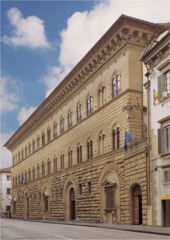
– patron= Cosimo de Medici
-Latin cross plan = traditional plan for medieval churches
-Prime residence @ peak of Medici family → expressive of wealth & political authority but much of it today = additions later on
-Masonry → visually asserts power & fortifies from foreign attack
– Tripartite rustication → staggering treatment of each storey
-Divided by horizontal stringcourses according to decreasing height
-Interior → monastic cloisters that provided light into palace = courtyard
-Where Donatello’s David once stood to be seen 360°
-Decorated w/ coat-of-arms in roundels → depict mythological figures
-Medici strongly interested in restoring antiquity
-Cameos duplicated in marble (i.e. competition btw Minerva & Neptune)
-Before it was filled in, there were corner loggias where visitor’s protocols were carried → private-public duality aspect
-Michelangelo filled them in w/ pedimented aediculae in 1517
-Massive cornice protruding out almost like a roof → distinctly Florentine
-prototype of Tuscan- Renaissance Palazzo
-clarity and order
– fenestration determined by harmony of facade
-simplistic
-bipartite windows
-cornice
-rusticated blocks= status symbol
-Donatello’s David in courtyard
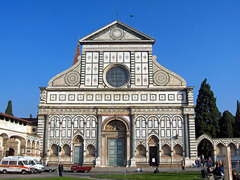
-Proof of Alberti’s great artistic adaptability
– He unified the façade by continuing Gothic design from the lower portion
-Order of pilasters & engaged columns harmonize w/ rest of structure
-patron= Guovanni Ruccelai
– pilasters and engaged columns unified facade
-cornice projections
-round windows
-volutes screening the lean-to roofs of the aisles inspired by Brunelleschi’s volutes on the lantern of the Duomo
-double scrolls= renaissance/baroque facade
-Florentine Arch

-prototype of pilaster facade
-pilaster system + traditional rusticated front
-gradation in rustication with storeys
– similar to Colosseum with different storeys
-frieze decorated w/ political devises
o Personal symbols intertwined → ostrich plumes & bejeweled plates
o Medici sails → represent Medici’s client to the public
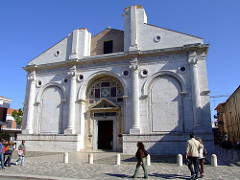
-Alberti
-closest approximation to antique monuments
-criticized for being too pagan
-medieval aisleless church= secular power
– fluted engaged columns and capitals
– monumental impact due to apparatus and volumes
-never finished
-first composition of facade based on unity as use of great, simple forms
-princely architecture
-imposing, absolutist manner
-collaboration of patron, advisor, and working architects
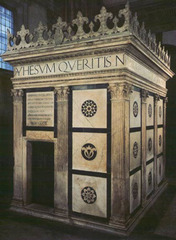
-many colored costly materials
-imitation of Holy Sepulchre in Jerusalem
-derived structural elements from baptistery in Florence
– onion cupolette imitation
-intricate stone work
-barrel vault of chapel

-patron= Ludovico Gonzaga
-oratory + votive church gave peculiar form
– centrally planned
-strangest Albertian work
-never finished
-narthex facade = peculiar in how high it goes
-hard to imagine original state
-Greek cross plan
– rises on basement storey
-pilasters support entablatures

-Andrea del Verrocchio → beautiful side tombs
-Tomb of Cosimo de’ Medici’s sons → male members of the family = lineage
-Giuliano di Lorenzo de’ Medici w/ Night & Day statues
o Lorenzo di Piero de’ Medici w/ Dusk & Dawn statues
-Tombs paid by Piero’s son and his paternal uncle
-Shares balance w/ Brunelleschi’s Old Sacristy in cubical space format surmounted by a dome and of pietra serena & white stucco
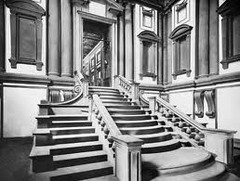
• Vestibule = explosion of originality fitting fanciful character of Mannerism
o Staircase spills out into vestibule → sense of momentum
o Appears like pouring forward = liquid → overwhelming the vestibule
o First free-standing staircase in architectural history
o Staircase itself in pietra serena = Brunelleschi; cool atmosphere
• Vestibule intensified b/c of Mannerist walls that are covered w/ classical antiquity elements in completely unconventional ways
o Brackets → also used in New Sacristy where they “support” heavier structure above; here they hang in purely decorative ways
o Free-standing columns framed in niches as if they were sculptures
o Michelangelo playing around & reinvented classical antiquity vocabulary
o Michelangelo’s virtuosity & knowledge of classical antiquity
• Warmer, more serious atmosphere → use of orderly classicism vocabulary
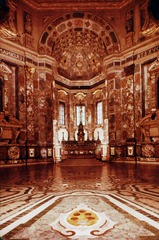
• His ambitions = lavish design of monumental chapel-museum w/ secular appearance → commemorate all princes of Medici dynasty
• Interior walls entirely encrusted in precious, colored marble
• Family tombs

• Exemplifies Renaissance ideals of urban planning → respect for Greco-Roman antiquity & mastery of central perspective
• Features triumphal arch; structure that looks similar to the Florence Baptistery (15th cent. mistaken as reused Roman temple); an amphitheater modeled after Colosseum in Rome
• Together reflect importance of security, religion, recreation in well-regulated city & value of Roman ideals in urban design
• Commissioned for palace of Duke Federico da Montefeltro of Urbino
• Problems of attribution & dating
• Patron = Pope Pius II elected 1458 (Aeneas Silvius Piccolomini)
• Indisputable influence of Michelozzo’s Palazzo Medici & his artistic idiom
• Plan determined in part by pre-existing streets → medieval town hall, and to either side of cathedral, bishop’s palace and his own Palazzo
o Forming a trapezoidal piazza
o Duomo’s triple-arched façade recalls ancient Roman triumphal arches
o Bishop’s palace → Tuscan in appearance & Roman style windows
• Pius’s architectural nucleus/renewal of the city
• Pattern on pavement “suggests” orderly relationship between buildings
• Question of authorship w/ Alberti similarly to Rucellai (only provided façade)
• Courtyard very similar to that of Palazzo Medici + triple-storey loggia
-• Patron = Lorenzo de’ Medici
• Miraculous vision 1484 → a child saw image of Madonna and Child painted on wall of public jail (carceri) of Prato animate itself → built basilica on that site
• External cover left unfinished → flat, 2D, Brunelleschian decoration
• Built on outskirts of town for pilgrims to pass by
• Greek cross plan with a central dome → indebted to Alberti & Brunelleschi
o Inspired by Brunelleschi or Michelozzo’s Pazzi Chapel
o Interior → Corinthian pilasters meet where walls meet at right angles
o Definition of beauty → Vitruvian man in architecture
• Brunelleschian motif → pietra serena (Sangallo trained by Brunelleschi)
o Bichrome like other Prato’s buildings → white & green marble
• Sangallo used the same idea for his project of St. Peter’s Basilica (superseded by Michelangelo) → inspired the Elder for S. Biagio @ Montepulciano
• Proving own ambition by so closely imitating Palazzo Medici but BIGGER
• Sangallo/Maiano’s contribution unimaginable w/o Michelozzo’s artistic idiom
• Same types of Florentine traditional motifs →
o Tripartite division by horizontal stringcourses
o Roman biforate windows
o Enormous, projecting cornice almost roof-like
o Open courtyard enclosed by four sides of colonnade w/o impost block
• Keystone of each arch articulated w/ corbels
o Convenient bench going around structure for the public to sit
• Status of owner reflected in crowdedness around building
• Advertising authority & popularity w/ intentional bench
• Difference → more unified rustication façade than Palazzo Medici
• Similar Florentine style = Palazzo Strozzi & Palazzo Medici
• Channeling ashlar masonry from rough rustication on piano nobile
o Used 3 colors of stone → forming of pattern and consistency
o But 3rd floor = regular ashlar masonry w/o channeling
• Appears subtle → smooth, unified surface
• Keystone + voussoirs decorating windows & not pediments
• Courtyard also similar to Strozzi & Medici → no impost blocks
• Patron = Cardinal Alessandro Farnese
• Central plan church = Greek cross plan
• Farnese family’s extensive power over this region → “owned” by Farnese
o Church politics and family name patronage → coat-of-arms decorations
o Farnese family almost replace Medici in importance of patronage
• Altar arm = apsidal extension → elongated Greek cross plan
• “Beveled crossing piers” → corners cut away producing polygonal space
o Influenced by Bramante’s plan for St. Peter’s Basilica in Rome
o Cut away corners used for altars, niches w/ sculptures, etc.
• Heavy use of rustic Doric order
small, rustic country church
-• Patron = Pope Leo X (Medici)
• Greek cross plan w/ central dome & semi-circular apse; flanked by 2 belltowers
o Belltowers = separate buildings but beautiful visual continuity = 4 stories
o Influenced by Bramante’s plan for St. Peter’s Basilica
• cf. S. Carceri → similar in design; clearly articulate ground plan
o Dome clearly visible vs. entirely absent in Prato
o Semi-circular extension of 1 arm → separate room housed in this space
o Combinations of pilasters & engaged columns aligning w/ church stories
o Heavy use of rustic Doric order; triglyphs & metopes on entablature
o Denser walls → niches & roundels cut into belltowers
o Moving away from Bru. → uniform use of local pinkish stone
-• Miraculous fresco 1518 → 2 women and a shepherd passed in front of fresco of Madonna and Child in her lap w/ St. Francis & saw Virgin’s eyes move
• Middle door flanked by 2 others leading into secret space behind altar
• Niches on either side of altar filled w/ aediculae
• Inside of drum → pattern of 3 niches in between each window
o Depth of niches alternate between deep and shallow
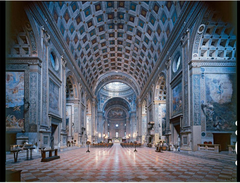
-Patron = Ludovico Gonzaga
-barrel vault nave
-tunnel vault above semicircle
-proportions calculated
-lighting= sublime
-monumental spaciousness
-brilliant application of ancient Roman triumphal arch motif echoed in interior
-Façade = of square proportions
-Painted coffers on ceiling barrel vault but real coffers on side barrel vaults
-Interior → rhythmic bays popularized in early 16th c. by Bramante




